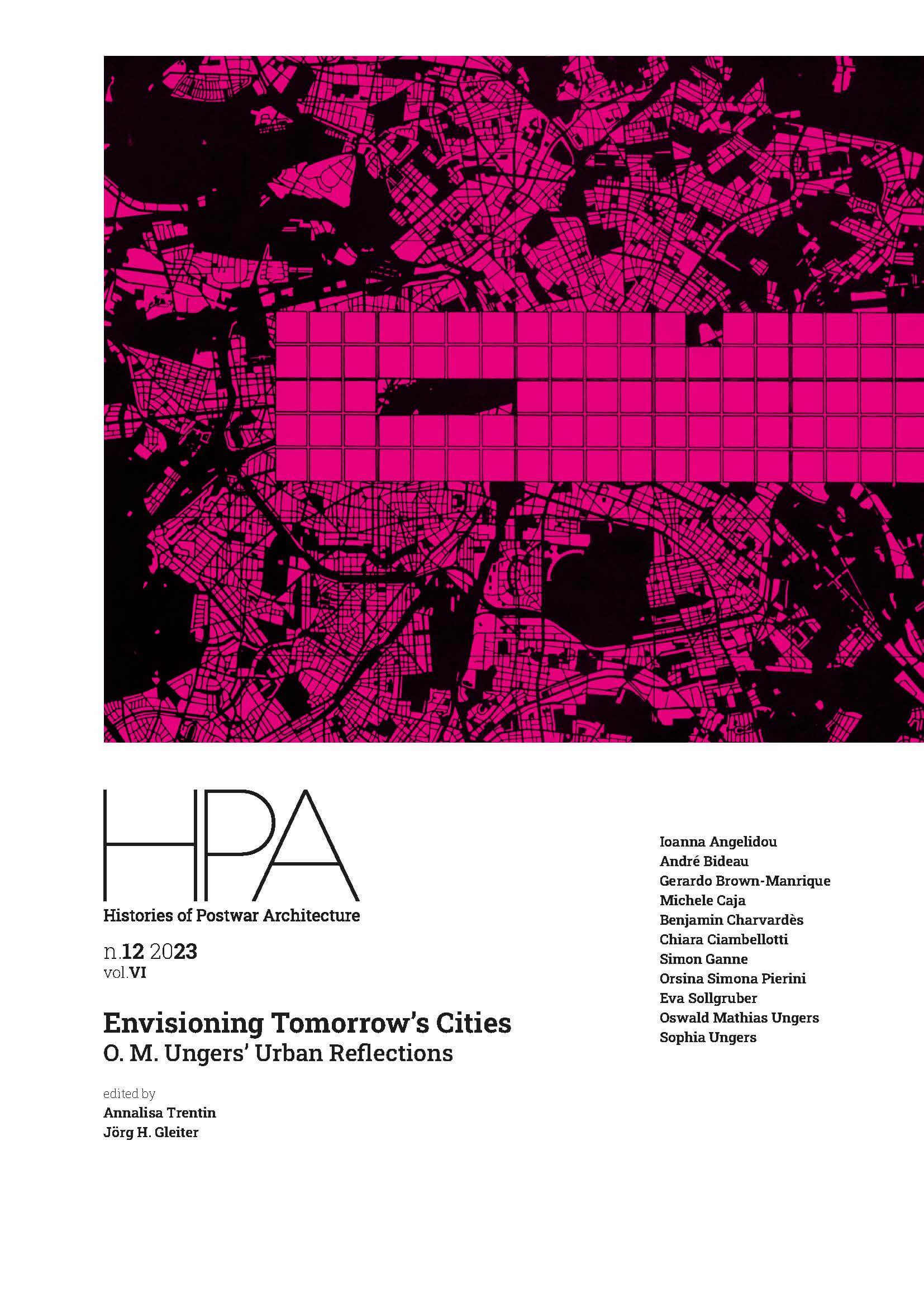Shifting Agency in Berlin: a Critical Decade
DOI:
https://doi.org/10.6092/issn.2611-0075/20306Keywords:
Urbanization and Governance, Social Housing, Urban Movements, Knowledge Production, Professional CrisisAbstract
There is a reciprocity between architecture production and urban publics, especially clear in times of professional crisis. For O.M.Ungers, Berlin served as a model for novel themes in a period when representations and demands of social groups were appearing in the urban realm. These challenged the Welfare State and the architecture production enmeshed with it. In a fragmented urban landscape, the urban villa introduced customized objects as “prototypes for inner city residences” (Ungers at al., 1978). Together with the more notorious Green Archipelago in the same year, the urban villa was the product of a Cornell Summer Academy that was premised on the manifest shortcomings of mass housing. Its participants in 1978 were avid observers of the material evidence that contemporary Berlin presented. Ungers was himself eager to re-legitimize his architectural practice after the crisis of mass housing in the same city during the late 1960s. The accompanying text, The Urban Villa, refers to a “personalization of lifestyle” and the “shift from the dependant tenant to the independant home owner”: a suburbanization of the already insular, provincial city? an early vehicle for Postmodernism? The interpretation of Berlin’s distressed urban condition certainly owes to experiences that Ungers had made in a geographical and a professional distance over the past decade. His gaze was conditioned by a distinctly different professional, social and cultural context that Cornell University and New York City had exposed him to since leaving Berlin to teach abroad. Yet structural changes affected cities and urban governance on both sides of the North Atlantic. In Ungers’s case, the ‘American’ experience can be argued as informing a novel reading of the fragmented Berlin. Which architectural agency can be related to knowledge derived from an urban realm that is itself changing? If anything, the two Summer Academies organized by Ungers and his colleagues from Cornell University offer a lens to look at how external forces condition the knowledge acquired by architects.
Downloads
References
Bernd and Hilla Becher. Anonyme Skulpturen : Formvergleiche industrieller Bauten. Düsseldorf: Städtische Kunsthalle, 1969
André Bideau, Architektur und symbolisches Kapital : Bilderzählungen und Identitätsproduktion bei O. M. Ungers. Basel: Birkhäuser, 2011
André Bideau, “Elusive Ungers”, AA Files, 64/2012, p.3-14
André Bideau, “Housing as a discursive void: Oswald Mathias Ungers in the 1960s and 1970s”, Candide 7/2013, p.70
François Burkhardt, Heinrich Klotz (ed.), Entwerfen in der historischen Strasse : Arbeiten des IDZ Symposiums im Herbst 1975 zur baulichen Integration Alt-Neu veranstaltet mit dem Senator für Bau- und Wohnungswesen. Berlin: Abakon, 1976
Jasper Cepl, Oswald Mathias Ungers : eine intellektuelle Biographie. Köln: Walther König, 2007, p.243, 254-256
Herbert Gans, The Urban Villagers: Group and Class in the Life of Italian-Americans. New York: The Free Press, 1965.
Dolores Hayden, Seven American Utopias. The Architecture of Communitarian Socialism, 1790-1975, MIT Press: Cambridge, 1976
Werner Hegemann, Das steinerne Berlin : Geschichte der grössten Mietkasernenstadt der Welt. Berlin: Kiepenheuer, 1930
Florian Hertweck, Sébastien Marot (ed.), The City in the City. Berlin: a Green Archipelago : A Manifesto (1977) by Oswald Mathias Ungers and Rem Koolhaas with Peter Riemann, Hans Kollhoff, Arthur Ovaska, Zürich: Lars Müller Publishers, 2013
Hans Hollein (ed.). “Man Transforms: An International Exhibition on Aspects of Design : For the Opening of the Smithsonian Institution’s National Museum of Design Cooper-Hewitt Museum : October 1976.” New York: Cooper-Hewitt Museum, 1976.
Bob Jessop: The Future of the Capitalist State, Cambridge 2002, p.8
Martina Löw, Helmuth Berking (eds.), Die Eigenlogik der Städte: neue Wege für die Stadtforschung. Frankfurt a.M: Campus Verlag, 2008
Erika Mühlthaler (ed.): “Lernen von O.M.Ungers”, Arch+ 181-182/2006
Werner Sewing: “Die Gesellschaft der Häuser”, Archplus, 187-188/1997-1998
Manfredo Tafuri: L’Architecture dans le Boudoir / The Ashes of Jefferson, in: M.Tafuri, The Sphere and the Labyrinth, Cambridge 1987, p.269-303
Lehrstuhl für Entwerfen VI. Prof. O.M.Ungers (ed.), “Berliner Brandwände”, Veröffentlichungen zur Architektur, Berlin: Technische Universität Berlin, 27/1969
Liselotte, O.M. Ungers, “Utopische Kommunen in Amerika, 1800-1900. Die Amana Community”, Das Werk, August 1970, p.543-546.
Liselotte Ungers, Oswald Mathias Ungers. Kommunen in der Neuen Welt, 1740-1971. Köln: Kiepenheuer & Witsch, 1972.
O.M.Ungers Werner Goehner, Arthuer Ovaska, Hans Kollhoff, The Urban Block and Gotham City. Metaphors & Metamorphosis. Two Concurrent Projects, College of Architecture, Art and Planning, Cornell University, Ithaca NY, 1976
Oswald Matthias Ungers, “Planning Criteria”, Lotus International 11/1976, p.14-41
Oswald Mathias Ungers, Hans Kollhoff, Arthur Ovaska, The Urban Villa. A Multi-family Dwelling Type. Cornell Summer Academy 77 in Berlin, Köln: Studio Press for Architecture, 1977
Oswald Mathias Ungers, “Architecture of the collective Memory. The infinite Catalogue of urban Forms’, Lotus 24/1979, p.5-11.
Oswald Mathias Ungers, Hans Kollhoff, Arthur Ovaska, The Urban Garden. Student Projects for the Südliche Friedrichstadt Berlin. Summer Academy for Architecture 78 in Berlin, Köln: Studio Press for Architecture, 1978
Oswald Mathias Ungers, “Cities within the City. Proposals by the Summer Academy for Berlin”, Lotus International, 19/1978, p.82-97
Oswald Mathias Ungers: Morphologie. City Metaphors, Köln 1982.
Downloads
Published
How to Cite
Issue
Section
License
Copyright (c) 2023 André Bideau

This work is licensed under a Creative Commons Attribution 4.0 International License.





